The air travel world has been living with the “3-1-1 liquids rule” (or its country-specific equivalent) for a long time now. In the United States, the TSA says you’re only been allowed to bring a quart-sized bag of liquids, aerosols, gels, creams and pastes through the checkpoint. They are limited to 3.4 ounces (100 milliliters) or less per item (well, with these 10+ exceptions)
How the rule started (and some fascinating history)
The rule came about in August, 2006. At that time, British authorities reportedly stopped a plot to blow up planes headed for the United States with liquid explosives. Initially, we weren’t allowed to carry ANY liquids or gels in our carry-on bags but that was eventually revised to allow small amounts under 100mls/3.4 ounces.
It’s been like that at just about every commercial airport around the world, ever since.
(By the way, this quick explanation of how the TSA managed to start the liquid ban, OVERNIGHT, is pretty fascinating. Unfortunately, it was part of the “legacy/obituary” for the guy who had been the TSA Administrator at the time, Kip Hawley. Anyway, go to the 5th paragraph down.)
In 2008, Hawley, on the agency’s blog, in a piece called “path forward on liquids,” suggested that 3-1-1 restrictions could be loosened as early as sometime in 2009, and they would remove the size limits on liquids in carry-ons. By May 2010, Christopher Elliott said on NBC News that it still hadn’t happened. At the time, Elliott said, “The 3-1-1 rule isn’t scheduled to be lifted until the end of this year [2010], when X-Ray machines at security checkpoints will have upgraded software proven to detect threat liquids in any configuration.”
We all know how that went.
Meanwhile, fast forward to today, and Hawley’s blog post is gone. Regardless, it’s been well over a decade since it was originally written, and 3-1-1 continues.
Better technology
The thing is, since that post was written, technology around the world has improved dramatically. Thanks to the improvement of computed tomography (CT) technology, airport security agents with CT scanners can have a much clearer view of what’s in your carry-on bag. In fact, in March, 2022, the first airport in the world ended its version of the 3-1-1 rule. Liquids (and electronics) at that airport can now remain in carry-on bags at the security checkpoint, and there are no restrictions on liquid volume.
In July, 2022, another airport announced the use of CT scanners, meaning the end of passengers carrying small bottles of liquids in their carry-on.
Amsterdam Schiphol has actually been using the technology for even longer – since 2020 – but the airport advises that passengers still use 100-milliliter containers, to avoid problems when flying to other jurisdictions.
So where does that leave us here in the good ol’ U.S. of A.?
The TSA has also invested in CT technology over the past few years and is slowly installing the new scanners at our 5,000 public-use airports. As of May 2021, TSA has more than 2,000 CAT units deployed nationwide at 228 airports. Unfortunately, that’s just a fraction of our commercial airports. But we’re a big country, and it’s a start.
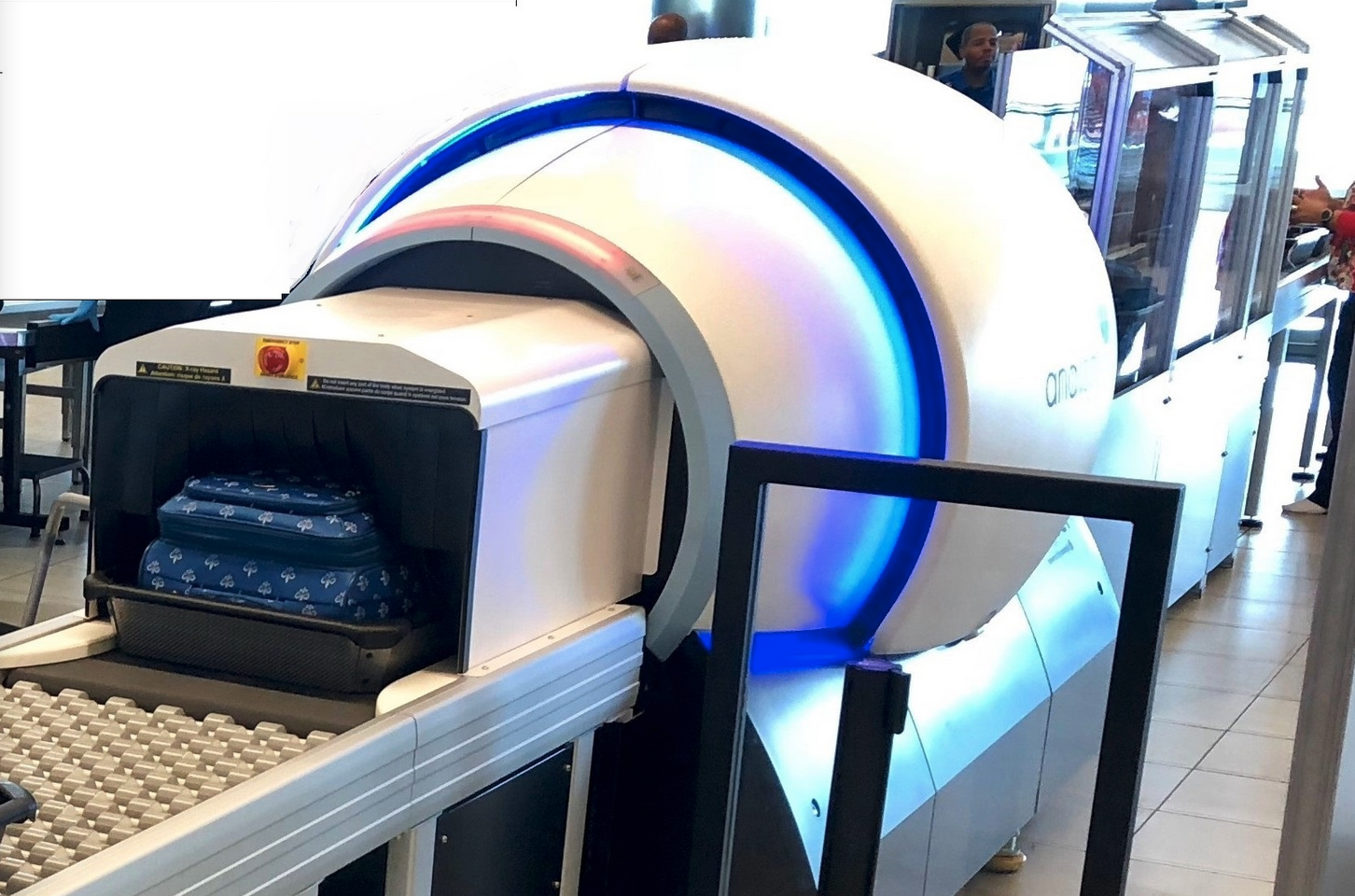
CT scanner at Elmira Corning Regional Airport. PC: TSA
Here’s what the TSA said in a press release when Harrisburg International Airport got one of these state-of-the-art CT scanners (boldtype is mine, for emphasis):
This equipment is similar to what is used to scan checked baggage for explosive devices, and has been “sized” to fit at checkpoints to create such a clear image of a bag’s contents that the system can automatically detect explosives, including liquids, by shooting hundreds of images with an X-ray camera spinning around the conveyor belt to provide TSA officers with the three-dimensional views of the contents of a carry-on bag.
The new technology sounded really cool. But it did get me wondering…if more and more checkpoints are getting CT scanners, why hasn’t the 3-1-1 rule changed for those airports that have them? Are we going to have to wait until every single airport in the U.S. has the new scanners? Or a certain percentage of them? Or until it’s available all around the world? Or…when?
I went to the source
So I did what any other citizen would do…I asked the TSA.
The MyTSA app has been around since 2011. The app honestly wasn’t worth much for a while, but it got a major update in 2019 that made it genuinely useful. The app has a link to AskTSA’s Twitter presence. Of course, you’re always welcome to go directly to Twitter and ask them there, too – TSA representatives are available to answer questions from 8am to 6pm ET.
Plenty of people just put their questions out there in a public tweet. However, DMs (Direct Messages) tend to work best for me. Here’s what I asked.
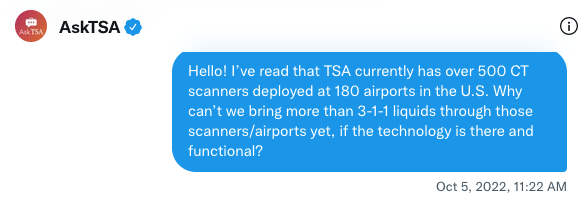
Hello! I’ve read that TSA currently has over 500 CT scanners deployed at 180 airports in the U.S. Why can’t we bring more than 3-1-1 liquids through those scanners/airports yet, if the technology is there and functional?
I got my answer 18 minutes later:
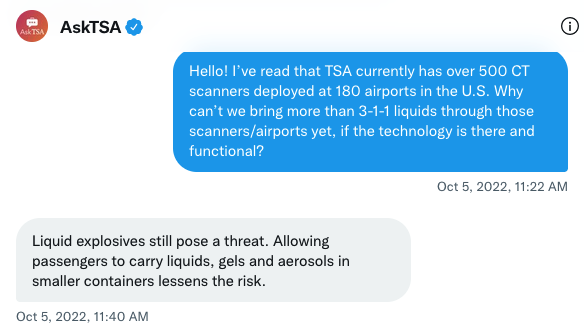
Liquid explosives still pose a threat. Allowing passengers to carry liquids, gels and aerosols in smaller containers lessens the risk.
I didn’t like the sound of that. It made it sound like the 3-1-1- liquid rule would go on for, you know, forever. But wasn’t CT technology going to help them know a threatening liquid when they saw it?
So, seeking clarification, I wrote to TSA again:
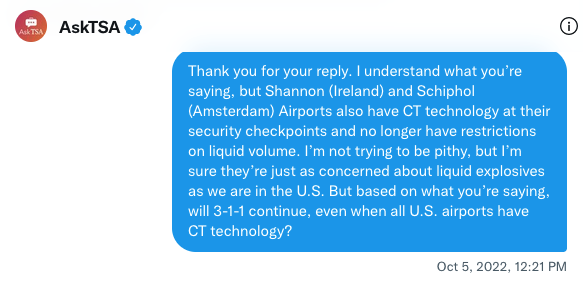
Thank you for your reply. I understand what you’re saying, but Shannon (Ireland) and Schiphol (Amsterdam) Airports also have CT technology at their security checkpoints and no longer have restrictions on liquid volume. I’m not trying to be pithy, but I’m sure they’re just as concerned about liquid explosives as we are in the U.S. But based on what you’re saying, will 3-1-1 continue, even when all U.S. airports have CT technology?
(Yes, I know I got the names of one of the airports wrong LOL)
Their reply?
Nothing. Not a word.
OK, maybe they were busy. So the next day I wrote to them again:
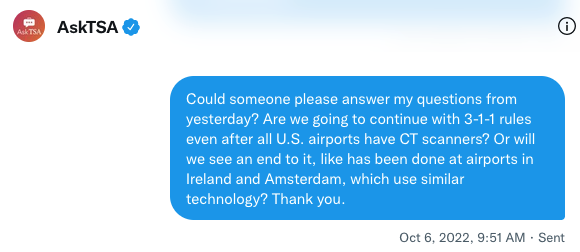
They never replied.
That was a year and a half ago and although I’ve seen several news articles about the future of airports and the TSA, the way they describe bringing liquids through in the future, after all airports are caught up, still sounds like there won’t be many changes in terms of the 3.4 ounces:
- In the future, the goal is to keep laptops and 3-1-1 liquids inside of the bag during checkpoint screening. (TSA)
- If a CT scanner is in use, the TSA officer will advise people to leave their electronics and travel size liquids in their carry-on bags. (TSA)
- We have the technology to end the airport liquid ban, so why is it still in place? (CNN)
Doesn’t look good
So your guess is as good as mine. But at this point, it sounds as if the 3-1-1 rule is here to stay, at least in the foreseeable future, simply because, “liquid explosives still pose a threat. Allowing passengers to carry liquids, gels and aerosols in smaller containers lessens the risk.”
Even though they’ve managed to stop it in some airports in Europe. And even though we were able to bring 12 ounces of hand sanitizer, and larger-than-3.4-ounces of medical liquids in our carry-on bags during the pandemic (and the original would-be bombers apparently didn’t try to use THAT much liquid to begin with). And even though the TSA themself said CT scanners could tell if a liquid is a threat or not.
So…I dunno.
Now, before anyone goes all, “IT’S ALL SECURITY THEATER!” on me (I know some of you are just chomping at the bit to reply with some version of that. Just remember to read this first to help ensure your comment gets approved), to an extent, I get what they’re doing. The TSA scanners are definitely a deterrent because of what they find – you just have to look at how many loaded guns they’ve found in carry-on bags and on people this year. But there’s also something to be said about if the public at large just THINKS the TSA is going to catch them doing something wrong, they won’t try it. Some people call that “security theater.” But you know what? Whether it’s because we’re actually secure/safe or the TSA just makes some of us feel like we could get caught, it’s worked…we haven’t had an attempted bomb on a plane via liquid explosives since 2006. 😉
Meanwhile The Telegraph recently wrote about the end of 100ml liquids eventually coming to the UK.
But for now, yeah, it sounds as if we’re going to have to live with the 3-1-1 for quite some time.
Feature Image (cropped): TSA
Want to comment on this post? Great! Read this first to help ensure it gets approved.
Want to sponsor a post, write something for Your Mileage May Vary, or put ads on our site? Click here for more info.
Like this post? Please share it! We have plenty more just like it and would love it if you decided to hang around and sign up to get emailed notifications of when we post.
Whether you’ve read our articles before or this is the first time you’re stopping by, we’re really glad you’re here and hope you come back to visit again!
This post first appeared on Your Mileage May Vary

3 comments
Domestic flights in Australia don’t have that restriction either, you can also accompany someone to the gate if you’re not flying.
TSA is garbage, they think they are doing the best by still having those restrictions. They like to publish when they detect something illegal but stopped publishing data about all the things the let through a long time ago.
If the 3-1-1 rule stays, then why invest in the CT scanner deployment? Can we get to self-scanning and eliminate TSA personnel? Doubt it.
Funny thing is, no one looked at my liquids when I flew out of SEA last week. And I absolutely had several > 100ml. Yes, I have TSA Pre-check/Global Entry /whatever so I didn’t have to take anything out of the bag, and maybe that’s it.
I won’t call it security theatre, I’ll call it typical US arrogance. Fortunately we have the scanners here in the UK and everywhere I’ve been in Europe recently so it won’t impact me.